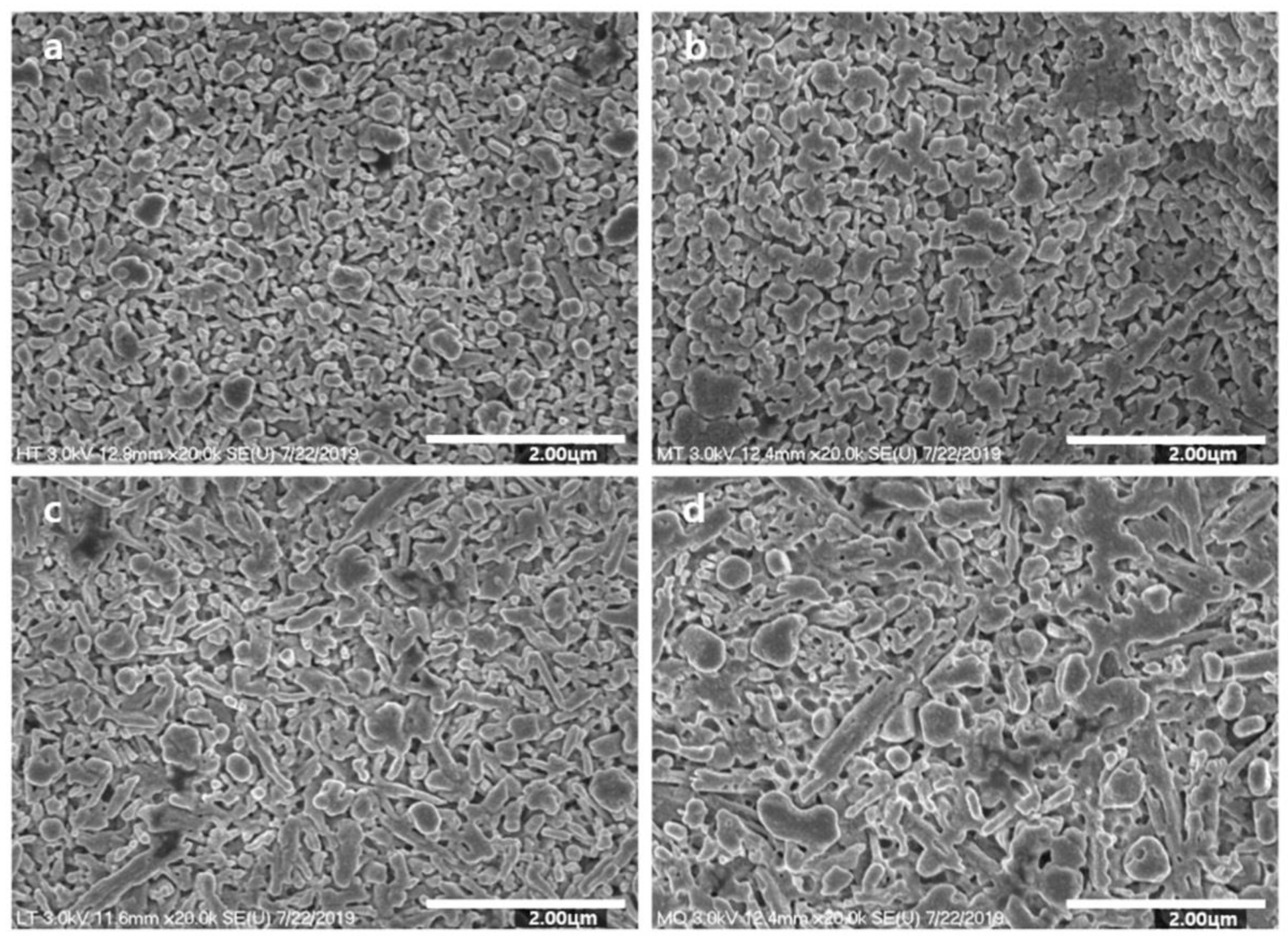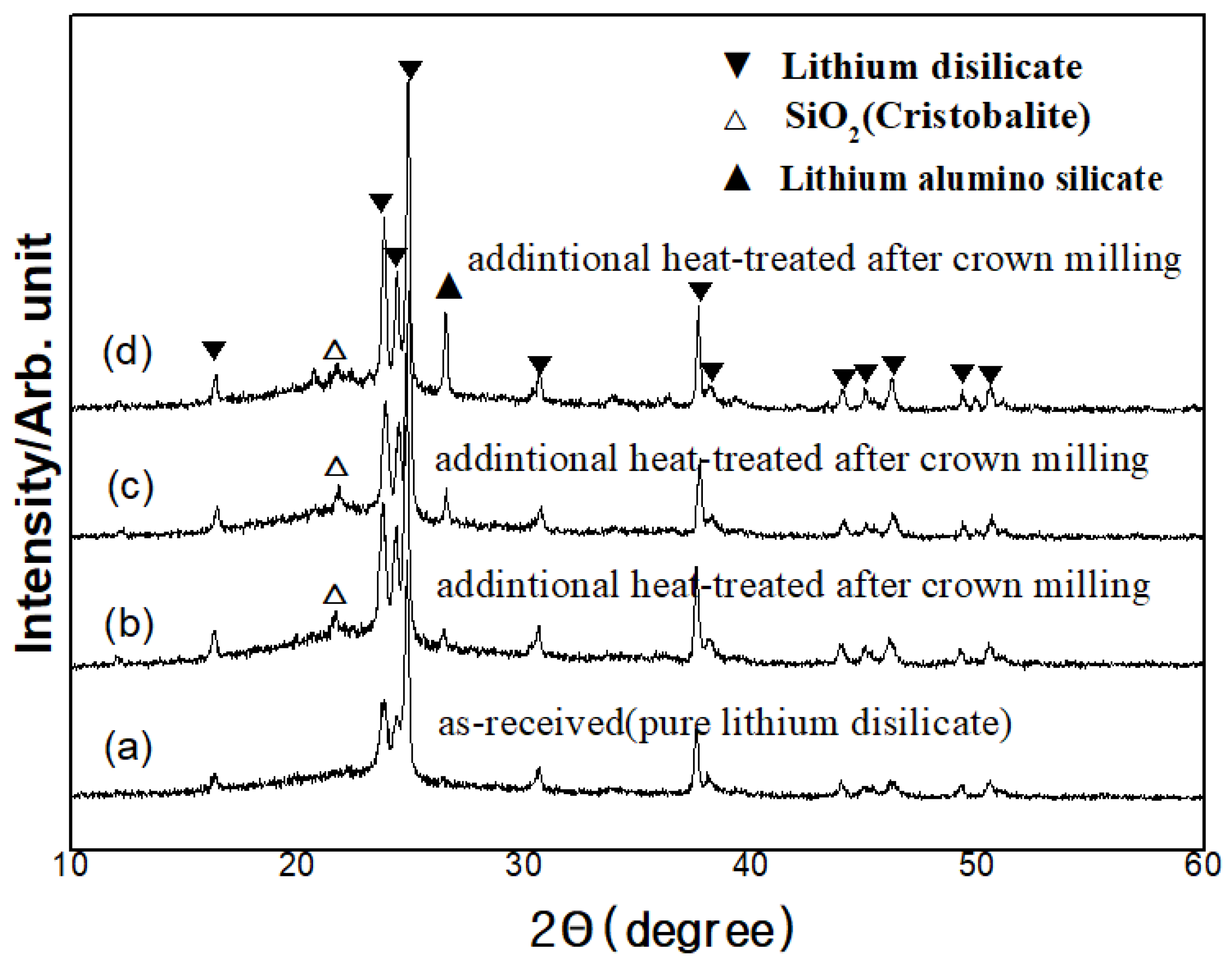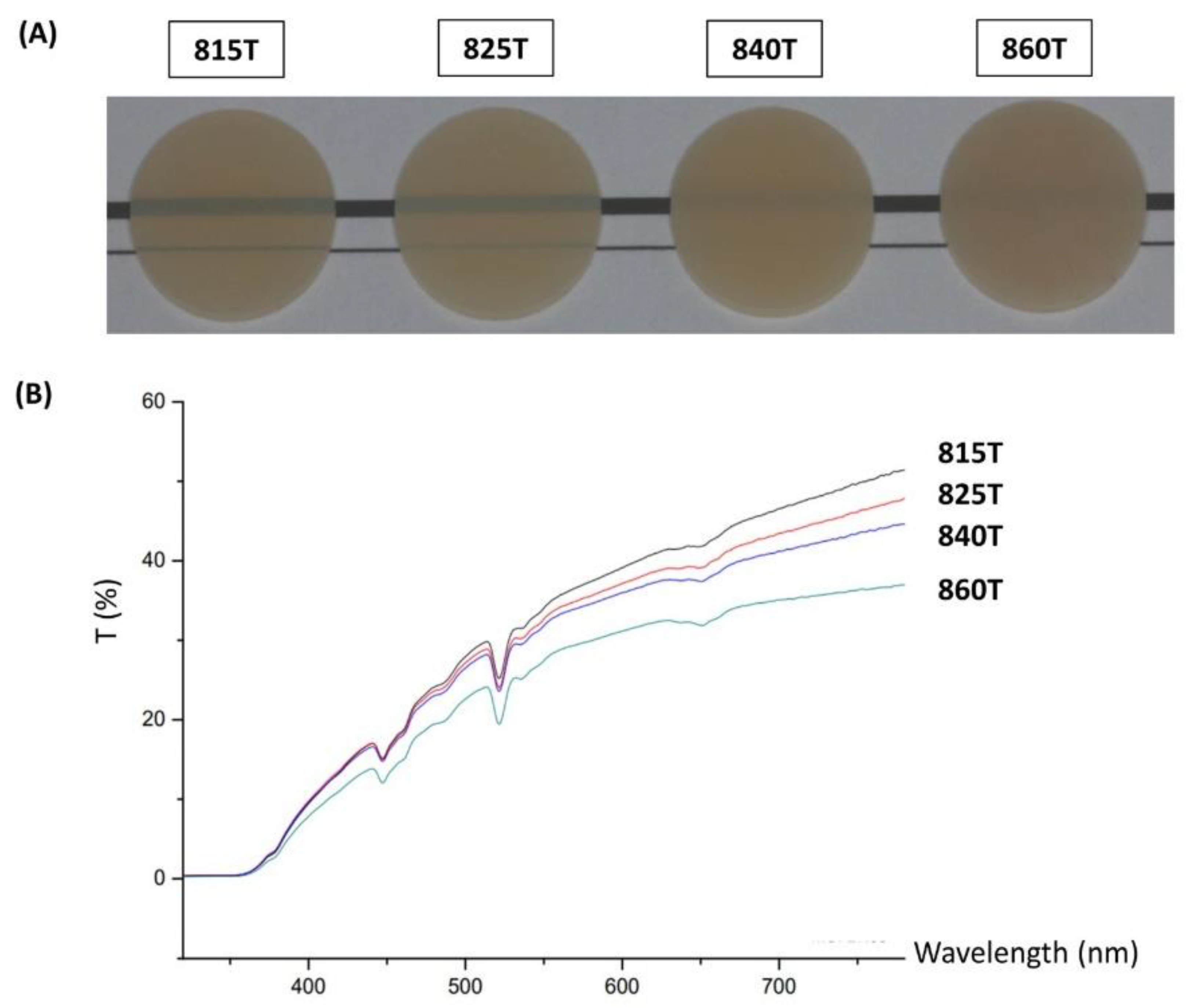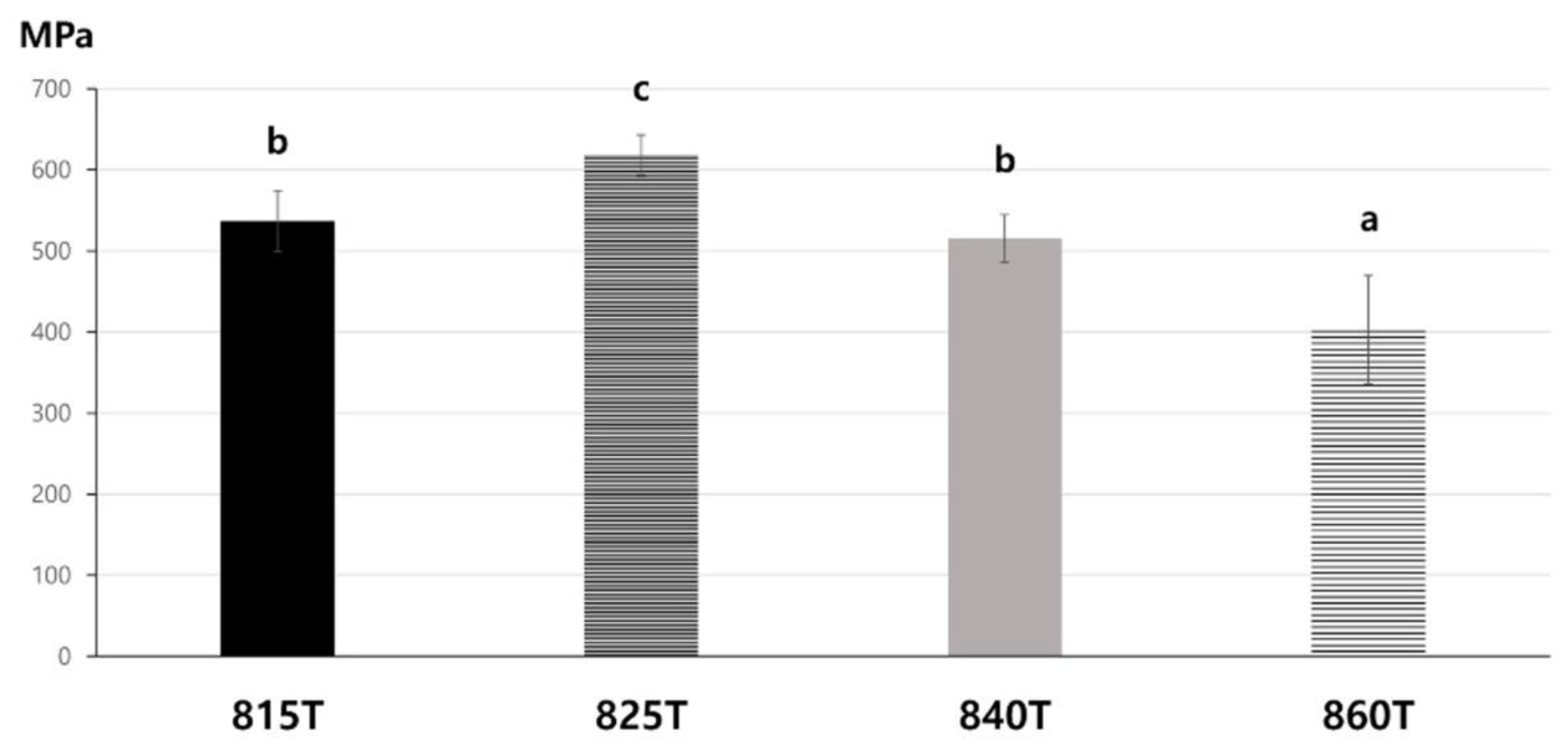Modulation of Lithium Disilicate Translucency through Heat Treatment
Abstract
1. Introduction
2. Materials and Methods
2.1. Specimen Preparation
2.1.1. Ceramic Block Preparation
2.1.2. Heating Schedule
2.2. Observation of Microstructure
2.3. Measurement of Optical Characteristics and Mechanical Properties
2.3.1. Visible Light Transmittance
2.3.2. Biaxial Flexural Strength
2.4. Statistical Analysis
3. Results
3.1. SEM Analysis
3.2. XRD Analysis
3.3. Translucency
3.4. Biaxial Flexural Strength
4. Discussion
5. Conclusions
Author Contributions
Funding
Institutional Review Board Statement
Informed Consent Statement
Data Availability Statement
Conflicts of Interest
References
- Zheng, X.; Wen, G.; Song, L.; Huang, X.X. Effects of P2O5 and heat treatment on crystallization and microstructure in lithium disilicate glass ceramics. Acta Mater. 2008, 56, 549–558. [Google Scholar] [CrossRef]
- Albakry, M.; Guazzato, M.; Swain, M.V. Biaxial flexural strength, elastic moduli, and X-ray diffraction characterization of three pressable all-ceramic materials. J. Prosthet. Dent. 2003, 89, 374–380. [Google Scholar] [CrossRef]
- Fischer, H.; Marx, R. Fracture toughness of dental ceramics: Comparison of bending and indentation method. Dent. Mater. 2002, 18, 12–19. [Google Scholar] [CrossRef]
- Willard, A.; Gabriel Chu, T.M. The science and application of IPS e.Max dental ceramic. Kaohsiung J. Med. Sci. 2018, 34, 238–242. [Google Scholar] [CrossRef] [PubMed]
- Fabian Fonzar, R.; Carrabba, M.; Sedda, M.; Ferrari, M.; Goracci, C.; Vichi, A. Flexural resistance of heat-pressed and CAD-CAM lithium disilicate with different translucencies. Dent. Mater. 2017, 33, 63–70. [Google Scholar] [CrossRef]
- Beall, G.H.; Duke, D.A. Transparent glass-ceramics. J. Mater. Sci. 1969, 4, 340–352. [Google Scholar] [CrossRef]
- Beall, G.H.; Pinckney, L.R. Nanophase Glass-Ceramics. J. Am. Ceram. Soc. 1999, 82, 5–16. [Google Scholar] [CrossRef]
- Vichi, A.; Carrabba, M.; Paravina, R.; Ferrari, M. Translucency of ceramic materials for CEREC CAD/CAM system. J. Esthet. Restor. Dent. 2014, 26, 224–231. [Google Scholar] [CrossRef]
- Anusavice, K.J.; Zhang, N.Z.; Moorhead, J.E. Influence of P205, AgNO3, and FeCl3 on color and translucency of lithia-based glass-ceramics. Dent. Mater. 1994, 10, 230–235. [Google Scholar] [CrossRef]
- Huang, S.; Huang, Z.; Gao, W.; Cao, P. Trace phase formation, crystallization kinetics and crystallographic evolution of a lithium disilicate glass probed by synchrotron XRD technique. Sci. Rep. 2015, 5, 9159. [Google Scholar] [CrossRef]
- Apel, E.; van’t Hoen, C.; Rheinberger, V.; Holand, W. Influence of ZrO2 on the crystallization and properties of lithium disilicate glass-ceramics derived from a multi-component system. J. Eur. Ceram. Soc. 2007, 27, 1571–1577. [Google Scholar] [CrossRef]
- Wang, F.; Gao, J.; Wang, H.; Chen, J.H. Flexural strength and translucent characteristics of lithium disilicate glass-ceramics with different P2O5 content. Mater. Des. 2010, 31, 3270–3274. [Google Scholar] [CrossRef]
- Holand, W.; Rheinberger, V.; Apel, E.; van’t Hoen, C. Principles and phenomena of bioengineering with glass-ceramics for dental restoration. J. Eur. Ceram. Soc. 2007, 27, 1521–1526. [Google Scholar] [CrossRef]
- Sen, R.; Dutta, S.; Das, S.K.; Basu, S.K. Evaluation of a glass-ceramic coating for machine tool slides. Wear 1989, 130, 249–260. [Google Scholar] [CrossRef]
- James, P.F.; Iqbal, Y.; Jais, U.S.; Jordery, S.; Lee, W.E. Crystallisation of silicate and phosphate glasses. J. Non Cryst. Solids 1997, 219, 17–29. [Google Scholar] [CrossRef]
- Wen, G.; Zheng, X.; Song, L. Effects of P2O5 and sintering temperature on microstructure and mechanical properties of lithium disilicate glass-ceramics. Acta Mater. 2007, 55, 3583–3591. [Google Scholar] [CrossRef]
- Borom, M.P.; Turkalo, A.M.; Doremus, R.H. Strength and Microstructure in Lithium Disilicate Glass-Ceramics. J. Am. Ceram. Soc. 1975, 58, 385–391. [Google Scholar] [CrossRef]
- Albakry, M.; Guazzato, M.; Swain, M.V. Fracture toughness and hardness evaluation of three pressable all-ceramic dental materials. J. Dent. 2003, 31, 181–188. [Google Scholar] [CrossRef]
- Chen, X.; Chadwick, T.C.; Wilson, R.M.; Hill, R.G.; Cattell, M.J. Crystallization and flexural strength optimization of fine-grained leucite glass-ceramics for dentistry. Dent. Mater. 2011, 27, 1153–1161. [Google Scholar] [CrossRef]
- Hing, P.; McMillan, P.W. A transmission electron microscope study of glass-ceramics. J. Mater. Sci. 1973, 8, 340–348. [Google Scholar] [CrossRef]
- Bischoff, C.; Eckert, H.; Apel, E.; Rheinberger, V.M.; Höland, W. Phase evolution in lithium disilicate glass-ceramics based on non-stoichiometric compositions of a multi-component system: Structural studies by 29Si single and double resonance solid state NMR. Phys. Chem. Chem. Phys. 2011, 13, 4540–4551. [Google Scholar] [CrossRef]
- European Committee for Standardization. Dental Ceramic; ISO 6872; European Committee for Standardization: Brussels, Switzerland, 1998. [Google Scholar]
- SAS Software, Version 9.4; SAS Institute Inc.: Cary, NC, USA, 2013.
- MedCalc Statistical Software, Version 18; MedCalc Software bv: Ostend, Belgium, 2020.
- Burgner, L.L.; Weinberg, M.C. An assessment of crystal growth behavior in lithium disilicate glass. J. Non Cryst. Solids 2001, 279, 28–43. [Google Scholar] [CrossRef]
- Denry, I.L.; Holloway, J.A. Effect of crystallization heat treatment on the microstructure and biaxial strength of fluorrichterite glass-ceramics. J. Biomed. Mater. Res. B Appl. Biomater. 2007, 80, 454–459. [Google Scholar] [CrossRef] [PubMed]
- Zhang, Y. Making yttria-stabilized tetragonal zirconia translucent. Dent. Mater. 2014, 30, 1195–1203. [Google Scholar] [CrossRef]
- Trunec, M.; Chlup, Z. Higher fracture toughness of tetragonal zirconia ceramics through nanocrystalline structure. Scr. Mater. 2009, 61, 56–59. [Google Scholar] [CrossRef]
- Apetz, R.; van Bruggen, M.P.B. Transparent Alumina: A Light-Scattering Model. J. Am. Ceram. Soc. 2003, 86, 480–486. [Google Scholar] [CrossRef]
- Ding, Y.; Jiang, S.; Luo, T.; Hu, Y.; Miura, Y.; Peyghambarian, N. Lithium disilicate crystalline slab waveguides from surface crystallised glass. Electron. Lett. 1999, 35, 504–505. [Google Scholar] [CrossRef]
- Zhao, M.; Sun, Y.; Zhang, J.; Zhang, Y. Novel Translucent and Strong Submicron Alumina Ceramics for Dental Restorations. J. Dent. Res. 2018, 97, 289–295. [Google Scholar] [CrossRef] [PubMed]
- Borba, M.; de Araújo, M.D.; Fukushima, K.A.; Yoshimura, H.N.; Cesar, P.F.; Griggs, J.A.; Della Bona, A. Effect of the microstructure on the lifetime of dental ceramics. Dent. Mater. 2011, 27, 710–721. [Google Scholar] [CrossRef]
- Barreiro, M.M.; Riesgo, O.; Vicente, E.E. Phase identification in dental porcelains for ceramo-metallic restorations. Dent. Mater. 1989, 5, 51–57. [Google Scholar] [CrossRef]
- Mackert, J.R., Jr.; Twiggs, S.W.; Russell, C.M.; Williams, A.L. Evidence of a critical leucite particle size for microcracking in dental porcelains. J. Dent. Res. 2001, 80, 1574–1579. [Google Scholar] [CrossRef]
- Faber, K.T.; Evans, A.G. Crack deflection processes—I. Theory. Acta Metall. 1983, 31, 565–576. [Google Scholar] [CrossRef]
- Denry, I.L.; Holloway, J.A. Elastic constants, Vickers hardness, and fracture toughness of fluorrichterite-based glass-ceramics. Dent. Mater. 2004, 20, 213–219. [Google Scholar] [CrossRef]
- Liao, W.H.; Tien, H.W.; Hsiao, S.T.; Li, S.M.; Wang, Y.S.; Huang, Y.L.; Yang, S.Y.; Ma, C.C.; Wu, Y.F. Effects of multiwalled carbon nanotubes functionalization on the morphology and mechanical and thermal properties of carbon fiber/vinyl ester composites. ACS Appl. Mater. Interfaces 2013, 5, 3975–3982. [Google Scholar] [CrossRef]
- Donald, I.W.; Metcalfe, B.L.; Wood, D.J.; Copley, J.R. The preparation and properties of some lithium zinc silicate glass-ceramics. J. Mater. Sci. 1989, 24, 3892–3903. [Google Scholar] [CrossRef]




| Groups | Standby Temperature (°C) | Standby Duration (min) | Firing Temperature (°C/min) | Holding Time (min) | Vacuum on/off Temperature (°C) | Furnace Head Open Temperature (°C) |
|---|---|---|---|---|---|---|
| 815T | 400 | 3 | 815 | 15 | 550/815 | 690 |
| 825T | 400 | 3 | 825 | 15 | 550/825 | 690 |
| 840T | 400 | 3 | 840 | 15 | 550/840 | 690 |
| 860T | 400 | 3 | 860 | 15 | 550/860 | 690 |
| Groups | Crystal Number Mean (SD) | Crystal Size (nm) | Distance between Crystals (nm) | |||
|---|---|---|---|---|---|---|
| Mean | Min | Max | SD | |||
| 815T | 2237.6 (89.2) | 240 | 10 | 370 | 56.43 | 0.19 ± 0.05 |
| 825T | 837.4 (56.1) | 600 | 240 | 570 | 63.18 | 0.29 ± 0.06 |
| 840T | 756.1 (58.6) | 740 | 240 | 1450 | 167.25 | 0.34 ± 0.09 |
| 860T | 330 (14.2) | 1080 | 260 | 2760 | 584.36 | 0.43 ± 0.14 |
| Groups | <200 | 200–400 | 400–600 | 600–800 | >800 |
|---|---|---|---|---|---|
| 815T | 71.88% | 28.12% | - | - | - |
| 825T | - | 42.42% | 57.58% | - | - |
| 840T | - | 15.15% | 51.52% | 24.24% | 9.09% |
| 860T | - | 5.88% | 17.65% | 35.29% | 41.18% |
| Results | 815T | 825T | 840T | 860T |
|---|---|---|---|---|
| Light transmittance percentage (%) * | 30.50 ± 0.21 d | 27.58 ± 0.38 c | 26.28 ± 0.31 b | 22.20 ± 0.38 a |
| Intraclass correlation coefficient † | 0.95 | 0.98 | 0.97 | 0.97 |
Publisher’s Note: MDPI stays neutral with regard to jurisdictional claims in published maps and institutional affiliations. |
© 2021 by the authors. Licensee MDPI, Basel, Switzerland. This article is an open access article distributed under the terms and conditions of the Creative Commons Attribution (CC BY) license (https://creativecommons.org/licenses/by/4.0/).
Share and Cite
Jung, S.-K.; Kim, D.W.; Lee, J.; Ramasamy, S.; Kim, H.S.; Ryu, J.J.; Shim, J.S. Modulation of Lithium Disilicate Translucency through Heat Treatment. Materials 2021, 14, 2094. https://doi.org/10.3390/ma14092094
Jung S-K, Kim DW, Lee J, Ramasamy S, Kim HS, Ryu JJ, Shim JS. Modulation of Lithium Disilicate Translucency through Heat Treatment. Materials. 2021; 14(9):2094. https://doi.org/10.3390/ma14092094
Chicago/Turabian StyleJung, Seok-Ki, Dae Woon Kim, Jeongyol Lee, Selvaponpriya Ramasamy, Hyun Sik Kim, Jae Jun Ryu, and Ji Suk Shim. 2021. "Modulation of Lithium Disilicate Translucency through Heat Treatment" Materials 14, no. 9: 2094. https://doi.org/10.3390/ma14092094
APA StyleJung, S.-K., Kim, D. W., Lee, J., Ramasamy, S., Kim, H. S., Ryu, J. J., & Shim, J. S. (2021). Modulation of Lithium Disilicate Translucency through Heat Treatment. Materials, 14(9), 2094. https://doi.org/10.3390/ma14092094







